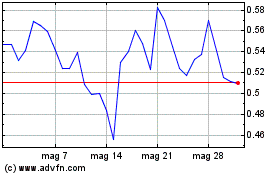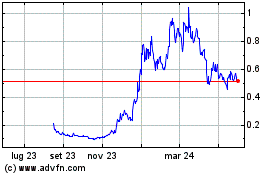Major Victory For Bitfinex: DOJ Declares $9 Billion In Stolen Bitcoin Should Be Returned
16 Gennaio 2025 - 7:30AM
NEWSBTC
The US Department of Justice (DOJ) has stated that around $9
billion in Bitcoin, taken from the crypto exchange Bitfinex in a
2016 hacking incident, ought to be returned to the exchange. This
claim arises from a legal document submitted by the DOJ, which
indicated that there are no recognizable victims in this specific
case within the existing legal structure. Bitfinex To Potentially
Reclaim Stolen Bitcoin The court documents, submitted on Tuesday,
explain that the recovery of the stolen Bitcoin—specifically 94,643
BTC, along with amounts from various hard forks—should be returned
to Bitfinex. The DOJ argued that under the Mandatory Victim
Restitution Act (MVRA), there is no legal basis to classify
Bitfinex or its account holders as victims of the specific offenses
for which the defendants were convicted. Related Reading: What
Bitcoin Election Patterns Could Signal For Its Price Ahead Of
January 20 Inauguration The defendants, Ilya Lichtenstein and
Heather Morgan, were convicted of Money Laundering Conspiracy, but
crucially, they were not charged with the initial hack that
resulted in the theft of the Bitcoin. According to the DOJ,
their subsequent actions did not directly cause the losses incurred
by Bitfinex. The legal definition of a “victim” as stated in the
MVRA requires a direct and proximate harm resulting from the
commission of a specific offense, which in this case reportedly
does not apply. Legal Challenges In Crypto Asset Recovery The DOJ’s
filing emphasizes that, while no mandatory restitution can be
ordered under the current convictions, the court retains the
authority to grant voluntary restitution. This means that, as
part of their plea agreements, the defendants have agreed to return
the stolen assets to Bitfinex. The restitution order proposed by
the DOJ would encompass all funds recovered from the Bitfinex Hack
Wallet. While this ruling marks a potential financial windfall for
Bitfinex, it also opens the door for further legal complexities.
The government is in the process of a third-party ancillary
forfeiture proceeding to address other seized assets linked to the
defendants’ laundering activities. These additional assets,
which were involved in complex laundering schemes, may not be
categorized as specific property lost by Bitfinex and its account
holders. Related Reading: XRP Bullish Surge Takes Price Within
Striking Distance Of $2.9 The 2016 Bitfinex hack, one of the
largest in cryptocurrency history, has had lasting repercussions,
leading to ongoing debates about regulatory standards and victim
restitution in the digital asset space. As this situation develops,
the parties involved in the case will be focused on the court’s
ultimate ruling about the return of the seized Bitcoin and its
impact on the future of cryptocurrency regulation and restitution
methods for future cases. The DOJ’s efforts aim not only to address
the financial losses experienced by Bitfinex but also to clarify
the legal ramifications related to digital asset theft. At the time
of writing, Bitcoin has managed to regain its bullish momentum with
a 4% rise in the past 24 hours towards the $99,100 level.
Featured image from DALL-E, chart from TradingView.com
Grafico Azioni Sei (COIN:SEIUSD)
Storico
Da Dic 2024 a Gen 2025

Grafico Azioni Sei (COIN:SEIUSD)
Storico
Da Gen 2024 a Gen 2025
